|
|
|
Sort Order |
|
|
|
Items / Page
|
|
|
|
|
|
|
| Srl | Item |
| 1 |
ID:
106617
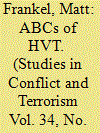

|
|
|
|
|
| Publication |
2011.
|
| Summary/Abstract |
The use of high value targeting (HVT)-using military and police forces to kill or capture leaders of insurgent and terrorist groups-has increased exponentially since the terrorist attacks of September 11, 2001. HVT operations have become the primary tool of the United States for combating Al Qaeda and its affiliates worldwide, and while these operations have eliminated scores of terrorists and insurgents from the battlefield, they haven't always led to strategic success. Utilizing a data set of 20 distinct HVT campaigns dating back to the end of World War II, this article will highlight the positive and negative effects of HVT efforts throughout history and identify six key lessons from past campaigns and their implications for the United States. The body of the paper looks at the important issues inherent to any HVT campaign, including the benefits of having a local force carry out the campaign, the importance of incorporating HVT into a larger counterinsurgency strategy, and the necessity of understanding the dynamics of the group being targeted. The United States has historically struggled in all of these areas, leading to difficulties in achieving success through HVT operations, but these historical lessons also provide opportunities for progress. The article concludes with important implications for the United States and identifies strategies for improvement in these pivotal areas, including expanding relationships with host governments, leveraging new technologies, and contemplating unique ways to approach target sets. Failure to make these changes, the article argues, will leave the United States with the same strategic failures it had with the infamous "deck of cards" in Iraq, where the focus on HVT at the expense of counterinsurgency both helped create and failed to stop the spread of a nationwide insurgency.
|
|
|
|
|
|
|
|
|
|
|
|
|
|
|
|
| 2 |
ID:
104260
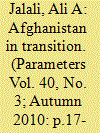

|
|
|
| 3 |
ID:
130422
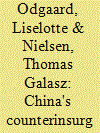

|
|
|
|
|
| Publication |
2014.
|
| Summary/Abstract |
China's counterinsurgency strategy in Tibet and Xinjiang relies heavily on hard power and imposition. Well-functioning vertical coordination in the security sector of China's political system and assimilationist nationality dynamics combine to favour the use of force against ethnic groups that do not accept the political legitimacy of China's Communist Party. Transnational links contribute to China's difficulties with implementing counterinsurgency in Tibet and help China implement its strategy in Xinjiang. Development strategies aimed at improving living standards are crowded out due to a lack of horizontal coordination between civilian and security agencies and a bias towards unitary nation-building in Chinese nationalism.
|
|
|
|
|
|
|
|
|
|
|
|
|
|
|
|
| 4 |
ID:
171224
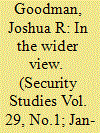

|
|
|
|
|
| Summary/Abstract |
Expeditionary counterinsurgents often have trouble adapting to meet insurgent challenges, resulting in the adoption and retention of ineffective strategies. Whereas explanations often focus on military preferences and cultures, this paper argues civilian policymakers ultimately select counterinsurgency strategy from the recommendations of their advisors, and these strategies will reflect policymakers’ preferences. The goals and instruments of a counterinsurgency campaign are significantly shaped and constrained by policymakers’ foreign policy objectives and the geostrategic pressures they perceive. Strategy changes when geostrategic shifts render existing strategies liabilities for new foreign policy objectives; otherwise, existing strategies, consistent with existing goals, are likely to persist. A most similar comparison of British responses to two insurgencies in the Palestine Mandate, the Arab Rebellion (1936–39), demonstrating successful strategic adaptation, and the Jewish Rebellion (1945–47), demonstrating the failure to change ineffective strategy, reveal the role played by geostrategic pressures stemming from the onset and aftermath of World War II.
|
|
|
|
|
|
|
|
|
|
|
|
|
|
|
|
| 5 |
ID:
110080
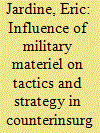

|
|
|
|
|
| Publication |
2011.
|
| Summary/Abstract |
This paper presents an analysis of the multiple effects of greater military materiel and troop quantities on the conduct of counterinsurgency. Although counterinsurgency is often considered a manpower intensive form of warfare, this paper posits that several dangers are inherent in the provision of more troops to the waging of such campaigns. Using the British counterinsurgency in Malaya as an illustrative, inductive case study, this article argues that greater materiel strength distorts the counterinsurgency's tactical and operational efforts, which can then dislocate their strategic plans.
|
|
|
|
|
|
|
|
|
|
|
|
|
|
|
|
| 6 |
ID:
152430
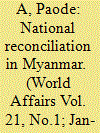

|
|
|
|
|
| Summary/Abstract |
Given the decaying military rule and reigning democratic government in Myanmar, Paode A highlights the various methods for national reconciliation adopted so far and argues that by altering both the military and USDP strategies for national reconciliation, the NLD may provide more suitable means and opportunities for resolving ethnic and political tensions.
|
|
|
|
|
|
|
|
|
|
|
|
|
|
|
|
| 7 |
ID:
130207


|
|
|
| 8 |
ID:
106715
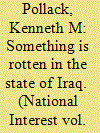

|
|
|
|
|
| Publication |
2011.
|
| Summary/Abstract |
WHEN I think of Iraq, I think of fire. First there is the obvious. With summer, the country becomes an inferno. The heat muscles its way past doors and windows, scoffs at fans, overpowers air conditioners and beats everyone senseless.
|
|
|
|
|
|
|
|
|
|
|
|
|
|
|
|
| 9 |
ID:
087093
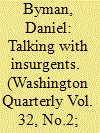

|
|
|
|
|
| Publication |
2009.
|
| Summary/Abstract |
Talking with insurgents is often a necessary first step toward defeating them or reaching an acceptable compromise. These talks must often be done even as insurgents shoot at U.S. soldiers, and they in turn, shoot at them. Iraq represents perhaps the most recent and notable case where diplomacy triumphed: U.S. efforts to reach out to Iraqi Sunni tribal groups, many of which were linked to various insurgent organizations, eventually paid vast dividends as these tribes ''flipped'' and began to work with the coalition against al Qaeda in Iraq. In Shi'a areas, both direct and indirect talks helped facilitate a ceasefire that has done much to keep Iraq's fragile peace intact.
|
|
|
|
|
|
|
|
|
|
|
|
|
|
|
|
| 10 |
ID:
110928
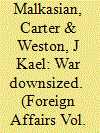

|
|
|
|
|
| Publication |
2012.
|
| Summary/Abstract |
The United States, facing deepening economic and fiscal woes at home, is preparing to withdraw from Afghanistan. More and more policymakers, congressional representatives, and members of the public are calling for the majority of U.S. forces to pull out as quickly as possible and for Washington to shift from an expensive counterinsurgency strategy, in which tens of thousands of U.S. and NATO troops protect the Afghan population, to a cheaper counterterrorism strategy, in which special operations forces strike at terrorist leaders in Afghanistan and Pakistan and the Afghans are left largely on their own.
|
|
|
|
|
|
|
|
|
|
|
|
|
|
|
|
| 11 |
ID:
138741
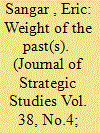

|
|
|
|
|
| Summary/Abstract |
This article seeks to explain the basic dynamics of the development of the German military approach in Afghanistan between 2003 and 2010 by looking at the impact of the Bundeswehr’s established uses of historical experience. First, the German military approach in Afghanistan has slowly evolved from a peacebuilding and mediation mission towards a full-fledged combat deployment. Second, the Bundeswehr’s exclusive focus on the World War II experience has contributed to the emergence of the Balkans experience as a formative experience that shaped initial operational thinking in Afghanistan. Third, because a thorough debate on the historical foundation of counterinsurgency remained absent, the operational shift in 2009 was perceived as a return to ‘classical’ military tasks and thus led to an almost exclusive focus on training for combat.
|
|
|
|
|
|
|
|
|
|
|
|
|
|
|
|
|
|
|
|
|